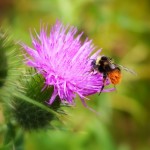BUMBLEBEES USE NICOTINE TO FIGHT OFF PARASITES

Bumblebees that have been infected by parasites seek out flowers with nicotine in the nectar – new research has found. The nicotine appears to slow the progression of disease in infected bees but has harmful effects when consumed by healthy bees.
Researchers from Queen Mary University of London (QMUL) and Royal Holloway, University of London (RHUL), gave bumblebees the option to choose between a sugar solution with nicotine in it and one without. Those bees infected with the Crithidia bombi parasite were more likely to go for the nicotine-laced nectar than those that weren’t infected.
Infected bumblebees that consumed nicotine delayed the progress of the infection for a few days, showing lower levels of parasites than those that had not. However, it did not increase the life expectancy of those bees, meaning that the direct benefits of nicotine for the bee colony remain to be identified.
Consuming nicotine also had negative effects, appearing to suppress the appetite of infected bees much like smoking does in humans. Healthy bees that consumed nicotine also showed shorter lifespans than those that did not consume any.

Bees are not the only species known to use nicotine to fight parasites, with house sparrows using cigarette butts in their nests to ward off mites.
Dr David Baracchi from the School of Biological and Chemical Sciences at QMUL, co-author of the research, said:
“While it’s clear that there is some benefit to nicotine consumption for parasite-infected bees, a key challenge now is to discover exactly how such natural medication limits the impact of the disease on the bees’ society.
“Given the stresses placed on worldwide bee populations by disease, understanding how the bees themselves fight infection is key.”
FACT BOX:
‘Weak and contradictory effects of self-medication with nectar nicotine by parasitized bumblebees’ by Baracchi D, Brown MJF and Chittka L. is published by F1000Research (2015, 4:73) (doi: 10.12688/f1000research.6262.1)
